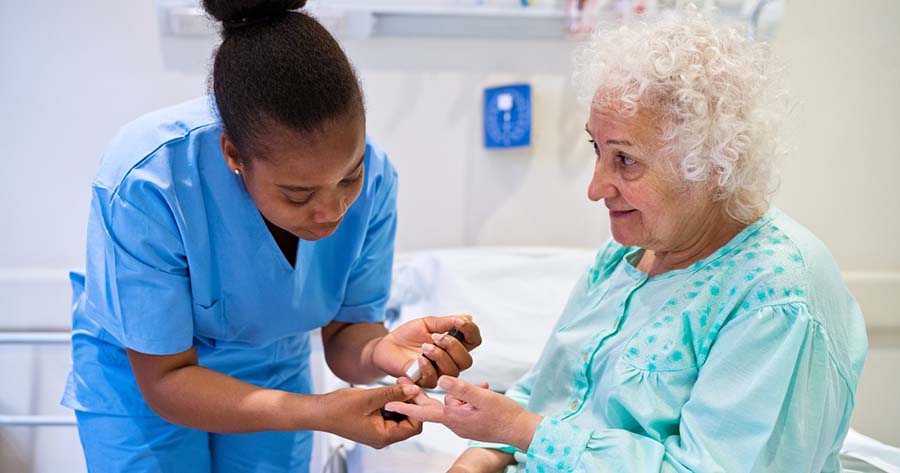According to the Quality Outcomes Framework (QOF) database there are now around 3.2 million people with diabetes in the UK (Diabetes UK, 2014). From Scottish data, around 4.5% of these people have had a foot ulcer, with a slightly higher occurrence in people with type 1 diabetes than type 2 diabetes; this is also true of major amputations (NHS Scotland, 2013).
Foot ulceration is the commonest serious chronic diabetes complication, affecting more people than blindness or renal failure (NHS Scotland, 2012). The ultimate consequence of ulceration – amputation – occurs as either major (above the ankle), or minor (partial foot) in 20% of ulcers (Holman et al, 2012). Amputations remain 15-times more common in people with diabetes than the non-diabetes population and around 50% of all lower limb amputations in the UK are performed due to diabetes (Holman et al, 2012). Effective foot care can reduce this by at least a half, as this is the typical reduction reported by diabetes multidisciplinary foot clinics across the UK and the rest of the world (Matricali et al, 2007). There are five main problems that affect the feet of people with diabetes and these are shown in Box 1.
Diagnosing neuropathy
Clinical diabetic sensorimotor peripheral neuropathy affects around 30% of people with diabetes (Young et al, 1993). The prevalence of neuropathy increases with age, duration of diabetes, glycated haemoglobin, increasing height and smoking. Many studies demonstrate that neuropathy is an ulceration risk factor and screening for loss of protective sensation is a cornerstone of the diabetes annual assessment (Monteiro-Soares et al, 2012).
When examining the foot, it is possible to recognise motor neuropathy by the classical signs of a high medial longitudinal arch, prominent metatarsal heads and pressure areas over the plantar forefoot, due to displacement and atrophy of the plantar fatty pad, and over the interphalangeal joints due to clawing of the toes from intrinsic muscle weakness. There will often be absent reflexes in the lower limb.
Similarly, foot autonomic neuropathy presents as dry skin and fissuring due to decreased sweating, and distended veins over the dorsum of the foot and around the ankle, due to arteriovenous shunting and calcification of vessels, which means that foot pulses are often “bounding”.
Sensory neuropathy can be detected by decreased vibratory sensation, impaired proprioception, or reduced nerve conduction velocities; however, the risk of foot ulceration is only increased when there is profound sensory loss and the commonest method for detection of this is the 10 g monofilament. Whilst testing protocols vary in terms of the number and position of sites, inability to detect the pressure of a 10 g monofilament is consistently associated with a 2–5 fold increase in the risk of foot ulceration. Monofilaments are the most widely used screening method for detection of increased foot ulcer risk; the Neuropathy Disability Score is less widely used (Young et al, 1993).
Using a monofilament
Bounce the monofilament on the individual’s hand to condition the monofilament; this will assure that it is buckling at 10 g when used on the foot and will enable the person to determine what it should feel like. This can be done by asking them to close their eyes and to respond when they feel the monofilament.
The monofilament should then be applied on selected sites, avoiding calloused areas. The sites recommended for high sensitivity are:
- Apex of hallux.
- First, second, third and fifth metatarsal heads.
Ensure that the monofilament bends about 1 cm but do not wiggle the monofilament (see Figure 1) The monofilament should be then removed and the process repeated on the next site.
Peripheral vascular disease
Impaired circulation is another major cause of foot ulceration and significantly increases the risk of a major amputation. People with both type 2 diabetes and type 1 diabetes and microalbuminuria are at increased risk of peripheral vascular disease (PVD). Atherosclerosis reduces blood flow by narrowing blood vessels and compromising oxygen delivery to tissues, which produces intermittent claudication, poor wound healing and eventually leads to devitalised tissue. In people with diabetes, pain is not always present in PVD as the symptoms may be masked by neuropathy.
On examination, feet with significant vascular impairment are often pale or mottled. The skin is typically thin, shiny and hairless. Touch of the feet and lower leg will reveal a cold foot, often with clear line of demarcation or a gradation down the leg from warm to cold. In extreme cases the foot will be red, due to ischaemic vasodilatation, or cyanotic blue.
Palpation of pulses is often undervalued, but is perhaps the most useful clinical technique to determine the adequacy of blood supply to a foot. The presence of one or more palpable foot pulses usually indicates adequate blood supply. The absence of both foot pulses has a poor prognosis.
The use of Ankle Brachial Pressure Index (ABPI) measurements in diabetes is more complicated than for individuals without diabetes. Medial arterial calcification increases in people with diabetes, particularly those with neuropathy and renal impairment, who are more likely to have vascular insufficiency. Arterial calcification makes the blood vessels harder to compress and falsely elevates the ankle systolic pressure. The ABPI compares the ankle with the arm systolic pressure. The normal range is 0.9–1.2 (Al-Qaisi et al, 2009). Due to arterial calcification, indices may be falsely elevated into the normal range, or even elevated above normal with incompressible arteries. A low reading will, however, be reliable and the sound of the wave (triphasic, biphasic, or monophasic) will also give clues as to the state of the vascular tree. For this reason, Doppler pressures are still recommended as first-line tests when the arterial circulation of a limb is in doubt.
Screening for foot ulcer risk
Assigning a foot ulceration risk category to a person with diabetes has been a requirement of the QOF for the past couple of years. This is based on a measure of protective sensation, usually using a monofilament, the presence or absence of foot pulses and previous history of ulceration or amputation (see Box 2). These are also outlined in Diabetes UK’s “Putting Feet First” campaign. If there is doubt about assigning a risk category, then Diabetes FRAME (www.diabetesframe.org) can provide the theoretical background for effective screening and risk stratification, as well as a printable CPD certificate, and is free to any UK healthcare professional. Individuals with at-risk feet should be referred for preventative podiatry care and those with active foot disease should be referred to the local multidisciplinary foot care team (MDT).
Painful neuropathy
Painful neuropathy is reported to affect around 10% of people with diabetes, and, of these, around 75% are likely to need treatment to control their symptoms (Gore et al, 2005; Davies et al, 2006). Whilst the diagnosis of painful neuropathy can be relatively simple to make, it is important to exclude other causes of foot pain.
Other diagnoses to consider include mechanical pain (such arthritis and plantar fasciitis); sciatica (frequently unilateral whereas diabetic painful neuropathy is normally bilateral); Morton’s neuroma (typically pain in a single web-space) and vascular insufficiency pain (particularly rest pain that is also worse at night).
Assessing painful neuropathy
Firstly, assess the characteristics of the pain by simple questions or a structured proforma, such as the modified Neuropathy Symptom Score (Young et al, 1993). Neuropathy pain is typically distal and bilateral, but may be asymmetrical. It is commonly described as numbness, tingling, burning, aching, or throbbing pain that is spontaneous (continuous or intermittent) and not stimulus-evoked; although allodynia and hyperalgesia can also be features. The pain is usually worse at night or at rest and often, in contrast to vascular pain, relieved by activity.
Neuropathic pain also has a considerable impact on mental and physical functioning, disturbing sleep and lowering mood. The treatment of neuropathic pain usually involves either antidepressant or antiepileptic drugs to modulate the mis-firing nerve pathways and central cortical responses. These are detailed in Table 1. Overall, no one drug is significantly better than any other and multiple drugs may be tried before an effective option is found.
Currently, there is no recognised evidence base for the use of acupuncture to treat painful neuropathy and it is not included in any national guideline. A small, uncontrolled study indicated that acupuncture may be a safe and effective treatment (Abuaisha et al, 1998), although further research is required.
Charcot neuroarthropathy
Charcot neuroarthropathy is an uncommon but serious foot complication that is often seen in people with diabetes and significant neuropathy. It presents as a hot, swollen foot and leg, which may, or may not, follow an episode of trauma. It is often mistaken for cellulitis or deep vein thrombosis, especially as initial X-rays may not show the characteristic destruction, dislocation and dissolution of bone in the early stages; the early stages is when the treatment works best.
If Charcot neuroarthropathy is suspected then early referral to a foot MDT can significantly reduce the risk of deformity and amputation. The main treatment is immobilisation, ideally in a non-removable cast. Serial plain X-rays, MRI scans, or isotope bone scans can be used to confirm the diagnosis but treatment should start on clinical suspicion to reduce the likelihood of significant deformity and subsequent ulceration.
Immobilisation should continue until the foot is no longer hot or swollen and is likely to be required for more than 6 months, and the individual should be advised of this. Once the heat and swelling subside, then there can be a graduated return to footwear, which might need to be custom-made to accommodate any deformity; this requires careful management to ensure the process does not restart.
Foot ulceration
The recent publication of variation in outcomes for people with diabetes foot ulcers is worrying (Holman et al, 2012). Nearly every diabetes guideline states that ulceration should be managed by diabetes foot specialists in an MDT. This is because MDTs reduce amputations, reduce admissions and reduce lengths of stay for those admitted (Kerr, 2012). However, MDTs do not exist in every hospital or regional diabetes service, and this accounts for some of the variation seen.
Ulcers develop due to pressure causing skin breakdown, and the resulting infection and ischaemia are the main reasons why some individuals proceed to amputation. In managing an ulcer, it is important to consider the factors listed in Box 3.
Management of foot ulcers
Both the ulcerated foot and non-ulcerated foot should be examined for vascular status, neuropathy, depth of ulceration and presence of infection. Each of these alters the management plan but, in general, there are three “gold standard” treatments for foot ulceration in a typical MDT, with revascularisation of the dysvascular foot when required. These are infection control, debridement and pressure off-loading. Without consideration of all three of these management options, healing is unlikely to occur and typically when individuals are referred to us with delayed healing, it is debridement and off-loading that have not been addressed adequately.
Infection control
Infection is a clinical diagnosis. The Infectious Diseases Society of America (IDSA) guideline (IDSA, 2012) defines relative levels of infection in foot ulceration. Treatment with antibiotics should be started based on local protocols if clinical infection is suspected and altered on the basis of adequate microbiological samples. This is not just a swab; tissue or liquid pus give better indication of the infecting organism. The IDSA classification is outlined in Box 4.
Debriding the diabetic foot
The most effective skill a clinician can have in ulcer management is the ability to use a scalpel appropriately. Adequate debridement removes infected and non-viable tissue, reduces bacterial load and removes dead tissue. It also enables deep tissue to be taken for culture and may encourage healing by converting a chronic into an acute ulcer. Levels of debridement will depend upon the skill of the practitioner and the vascular status of the person with diabetes. Larvae, hydroscalpels and chemical debridement may all have a place in wound care but the scalpel should be the instrument of choice. If the diabetes nurse does not have these skills then they should refer to a specialist, usually a podiatrist.
The arrival of biotechnologies in the 1990s increased the drive to improve debridement and the phrase “wound bed preparation” was coined; this still influences treatment today (Sibbald et al, 2000). It is vital that a bleeding base is achieved in neuropathic debridement and sometimes the bone and tendon must also be removed, often in the outpatient clinic.
Pressure relief
Off-loading ulcers is essential if healing is to be achieved. There are many different ways to off-load, but if a neuropathic wound is not healing, ask the patient about adherence and then try a different method (Box 5). It is important to ensure the individual is happy with the treatment, as adherence will impact on the effectiveness of a device. The total contact cast has long been regarded as the gold standard device for off-loading plantar ulcers but recent evidence suggests other non-removable devices may be as effective (Morona et al, 2013).
Dressings
The common failing in many referrals is that various dressings have been tried without the basic triad of managing ulcers. In dressing selection, there is little evidence to inform definitive choices. More manufacturers are performing randomised studies of dressings, so this may improve. Until then, however, it is prudent to choose a wound dressing that covers, absorbs, does not cause trauma on removal, and that you are familiar with and understand how it works.
Glucose control
People with foot ulcers have poorer diabetes control than the general diabetes population. One small, uncontrolled study suggested healing improved with better glucose control (Rubinstein and Pierce, 1988); however, a larger study (n=245) did not find this (Marston et al, 2006). Furthermore, an attempted randomised controlled study (Idris et al, 2005) could not recruit safely, so this remains unproven.
Concordance
The role of the individual with diabetes in minimising activity, using their off-loading device, taking antibiotics and attending for treatment should not be underestimated. Sometimes it is better to compromise on the perceived “ideal” treatment to increase compliance and the chances of the wound healing (Waajiman et al, 2013).
Secondary prevention
People with diabetes have a 50% risk of re-ulceration within one year and some studies demonstrate significant reductions with insoles and appropriate footwear (Maciejewski et al, 2004). Studies have shown that individuals with diabetic foot ulcers have a 50% chance of mortality in five years (Young, 2012), although an uncontrolled study in our own clinic suggests that attention to cardiovascular risk management can significantly improve this (Young et al, 2008). Therefore, optimal cardiovascular management is as important as foot care, if the individual is to survive.





Key scientific developments presented at the conference.
6 Aug 2025